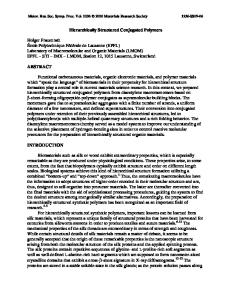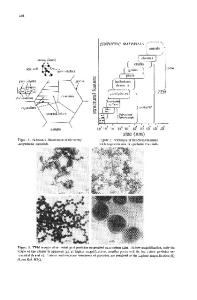Inorganic-Organic Hybrid Hierarchically Structured Methyl-modified Silica Monoliths
- PDF / 1,414,230 Bytes
- 8 Pages / 612 x 792 pts (letter) Page_size
- 69 Downloads / 294 Views
EE3.1.1
Inorganic-Organic Hybrid Hierarchically Structured Methyl-modified Silica Monoliths Doris Brandhuber1, Nicola Hüsing1,* and Herwig Peterlik2 1 Institute of Materials Chemistry, Vienna University of Technology, Getreidemarkt 9/ 165, A1060 Vienna, Austria 2 Institute of Materials Physics, University of Vienna, Boltzmanngasse 5, A-1090 Vienna, Austria
ABSTRACT Highly porous inorganic-organic hybrid monoliths with mesopores in a macroporous network have been prepared from methyltris(2-hydroxyethoxy)silane (MeGMS) and tetrakis(2hydroxyethoxy)silane (EGMS) in the presence of an amphiphilic block copolymer. The amount of methyltris(2-hydroxyethoxy)silane (MeGMS) in the gel has been varied from 0 to 100 %. These glycol-modified silanes have the advantage of being water-soluble and thus allowing for a direct templating of liquid-crystalline surfactant mesophases without the presence of a homogenizing organic solvent such as ethanol. The wet gels have been dried by supercritical extraction with carbon dioxide. In the present work, the sol-gel behaviour of these glycol-modified silanes is discussed especially with a focus on the formation of the meso- and macrostructure. In addition, the influences of the varying ratios of methyltris(2-hydroxyethoxy)silane on the structural features of the gels are investigated by various analytical techniques such as small angle X-ray scattering, nitrogen sorption, and scanning electron microscopy.
INTRODUCTION Monolithic silica-based gels exhibiting a highly porous structure with a hierarchical organization of the pores and well-defined surface properties are of interest, e.g. for chromatographic applications. Nakanishi and coworkers have shown for a variety of systems that silica monoliths with a co-continuous macroporous morphology can be prepared relying on phase separation phenomena e.g. by the presence of a polar solvent such as formamide or by spinodal decomposition during sol-gel transition induced by the presence of an organic polymer.[1,2] Lindén and Nakanishi extended this approach to materials with weakly organized mesopores by applying a combination of macroscopic (PEO) polymer-controlled phase separation and mesoscopic phase separation induced by an ionic or non-ionic surfactant as structure-directing agent in the nanometer regime.[3,4] In these porous materials, inorganic network formation is typically initiated by hydrolysis and condensation reactions of alkoxysilanes. This so-called sol-gel process allows direct access to surface and network modification of silica gel systems by using mixtures of tetra- and organotrialkoxysilanes. This has been shown earlier for hydrophobic and functional highly porous silica aerogel monoliths, but also for macroporous gels prepared by phase separation strategies.[5-8] Only very few studies report the formation of monoliths from pure silsesquioxanes e.g. methyltrialkoxysilanes.[9,10] This can probably be attributed to a) the lower degree of crosslinking that is expected when precursors are used with only three potential reaction si
Data Loading...










